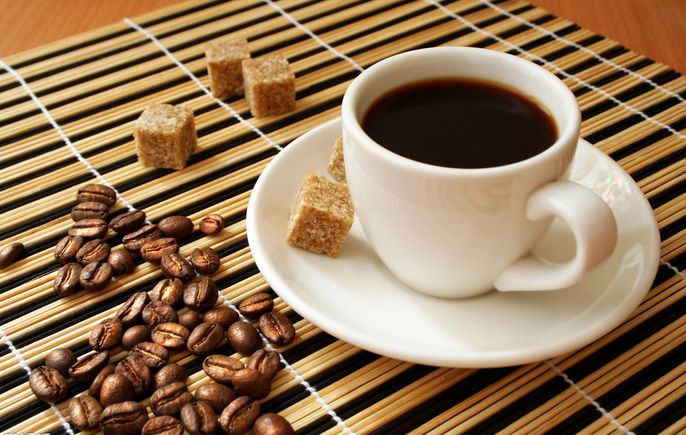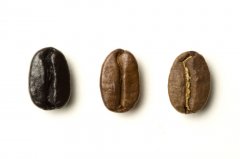The name of Mantenin Coffee comes from the producing area of Mantenin Coffee

For professional baristas, please follow the coffee workshop (Wechat official account cafe_style)
The origin of the name of Manning coffee
Manning is not the name of the producing area, the place name, the port name, nor the name of the coffee breed. How did it get its name?
In fact, it is a phonetic error of the mandheling people in Mandaining, Indonesia.
During the Japanese occupation of Indonesia during World War II, a Japanese soldier drank mellow coffee in a cafe, so he asked the shopkeeper the name of the coffee, and the boss mistook him for asking where you were from, so he replied: Mandaining. After the war, the Japanese soldiers recalled the "manning" they had drunk in Indonesia. As a result, 15 tons of Indonesian coffee was transported to Japan, which was very popular. That's how Manning's name came out, and the coffee merchant is now the famous PWN Coffee Company.
Known as Mantenin mandheling, it is produced around Lake Toba in northern Sumatra. The finished product has a unique fragrance of herbs and trees.
Gold Mantenin, the Japanese adopted more stringent quality control more than a decade ago. After picking beans manually for four times, they eliminated defective beans and produced gold mantenin with dark green color and equal appearance of beans, creating another wave of market demand. Even Europe and the United States are crazy about it.
The aged Agedmandheling is as sweet as honey. The successful old bean has worn away Manning's inelegant sour taste. The sour ingredients are ripe and converted to sugar, making the coffee more round and sweeter to drink. Manning is like a coffee zombie in the old age of failure, and the taste is hard to taste.
What's the specialty of manning coffee?
Manning Coffee is produced in Sumatra, Indonesia, Asia, also known as "Sumatran Coffee". Her flavor is very rich, fragrant, bitter, mellow, with a little sweetness. Most coffee lovers drink on their own, but it is also an indispensable variety for blending coffee.
At a time when Blue Mountain had not yet been made public, Manning coffee was considered to be the best product in the world. after baking, the beans were very large, raw beans were brown or dark green, caramel-like special flavor, mellow taste, sweet and bitter without soft acidity, but bitter taste. The production volume is relatively small, so the price is slightly higher than the general coffee beans.
Manning Coffee processing
Sellers often mark Lintong Lindong and Mandheling Manning coffee as dry. In fact, the pulp and coffee seeds are often separated by a variety of mixing modes, and the more common is a backyard wet treatment. The smart farmer put the freshly picked coffee cherries into a simple peeling machine made of scrap metal, wood and bicycle parts. Then put the peeled sticky beans in a plastic woven bag to ferment overnight. The next morning the soft pulp and slime that had been fermented were manually washed away. The silver-coated coffee is pre-dried on a sheet in the front yard and sent to the middleman's warehouse to remove the silver skin and further dry. Finally, the coffee was trucked to Port Medan in Medan, the capital of Sumatra, for the third and final drying.
It is also reported that in other Mandheling Mantenin producing areas, after peeling, the sticky material is allowed to dry and attach to the beans, just like the semi-washing treatment in Brazil. Then use a machine to remove the sun-dried sticky and silver skin. Finally, it goes through the same two-stage drying, first in the middleman's warehouse and then in the exporter's warehouse in Medan's port of Medan.
The processing process and Sumatran characteristics. I describe these treatments in such detail because it is not clear how the soil and atmosphere and the unusual treatment techniques and the three-stage drying each affect the formation of the characteristics of Lindong and Manning coffee. Only one thing is certain. These treatments occasionally produce excellent coffee and are extremely unstable. Only through the merciless selection in the Medan port exporter's warehouse can the deep texture and unique and low-key rich taste of Lintong Lindong and Mandheling Mantenin emerge from the interference of other smells.
The gentleman in coffee, Sumatra Manning, is a fine coffee bean grown in the original Michael Mountains at an altitude of 750 Murray 1500.
In the 17th century, the Dutch first introduced Arabica saplings to Ceylon (present-day Sri Lanka) and Indonesia. In 1877, a large-scale disaster hit the Indonesian islands, coffee rust destroyed almost all the coffee trees, people had to give up Arabica, which had been in operation for many years, and introduced the disease-resistant Robusta coffee tree from Africa. Indonesia today is a big coffee producer. Coffee is mainly produced in Java, Sumatra and Sulawi, with Robusta accounting for 90% of the total production. Sumatra Manning is a rare Arabica species. Planted on hillsides between 750m and 1500 m above sea level, the mysterious and unique Sumatran species give Mantenin coffee a rich aroma, rich taste, strong flavor, slightly chocolate and syrup flavor. Mantenin coffee beans have large granules and hard beans, and they are prone to defects in the process of planting. After harvest, they are usually subject to strict manual selection. If the control process is not strict enough, it is easy to cause a mixture of good and bad quality. in addition, the different degree of baking will also directly affect the taste, so it has become a more controversial single product.
The most famous coffee producers in Asia are the islands of Malaysia: Sumatra, Java and Gary Mann.
Sumatra manning coffee from the Indonesian island of Sumatra is the most famous, with two famous names, Sumatra mantenin DP first class and collection Sumatra mantenin. Sumatra Mantenin DP has a long aftertaste, with a hillside fragrance, which is unique to the earthy taste of the primeval forest. In addition to the mellow taste of Indonesian coffee, there is also a bitter sweet taste, sometimes mixed with a touch of mildew, which is popular with people who like to drink concentrated roasted coffee. Sumatra manning coffee is called "classic" because it is stored in the cellar for three years before export. But the collection coffee is not old coffee, but slightly pale coffee through special treatment, this kind of coffee is more full-bodied, the acidity will decrease, but the mellowness will increase, the finish will be longer, and will bring a strong spicy flavor, sometimes sour, sometimes walnut, sometimes chocolate. Before Blue Mountain Coffee was discovered, Manning was regarded as the best coffee.
Sumatra manning coffee from the Indonesian island of Sumatra is the most famous, with two famous names, Sumatra mantenin DP first class and collection Sumatra mantenin. No one knows what DP in Sumatra Mantenin DP I means, but one thing is certain, that is, of all the coffee in Indonesia, the grade DP is the most expensive.
Sumatra Mantenin DP has a long aftertaste, with a hillside fragrance, which is unique to the earthy taste of the primeval forest. In addition to the mellow taste of Indonesian coffee, there is also a bitter sweet taste, sometimes mixed with a touch of mildew, which is popular with people who like to drink concentrated roasted coffee.
Sumatra manning coffee is called a "classic" because it is stored in a cellar for three years before it is exported. But the collection coffee is not old coffee, but slightly pale coffee through special treatment, this kind of coffee is more full-bodied, the acidity will decrease, but the mellowness will increase, the finish will be longer, and will bring a strong spicy flavor, sometimes sour, sometimes walnut, sometimes chocolate.
Manning Coffee producing area
Manning Coffee is produced in Sumatra, Indonesia, Asia, also known as "Sumatran Coffee". The main producing areas are Java, Sulawesi and Sumatra, 90% of which are Robusta species. Among them, the "Manning" produced in Sumatra is the most famous. The best of the exquisite traditional Arabica coffee produced in northern Sumatra of Sumatra is sold as Lindong Lintong and Manning Mandheling. To be exact, Lindong Lintong refers to coffee growing in a small area in the southwest of Lake Toba in Lindong District. The small coffee growing area is scattered on a high and wavy clay plateau full of fern covers. Lintong Lindong Coffee is grown without shade, does not use chemicals, and is almost entirely owned by small private owners. Mandheling Manning is a broader term that includes Lintong Lindong Coffee and similar conditions of Diari (the capital Sidikalang) and the northern growing area of Lake Toba.
Manning brown
Her flavor is very rich, fragrant, bitter, mellow, with a little sweetness. Most coffee lovers drink on their own, but it is also an indispensable variety for blending coffee.
Mantenin has a strong taste, with a strong mellow and rich and lively sense of movement, neither astringent nor sour, mellow and bitter can be fully revealed. The appearance of Mantenin coffee beans is arguably the ugliest, but coffee fans say that the worse the Sumatran coffee beans are, the better, mellow and slippery they are. Manning coffee is considered to be the most mellow coffee in the world. When tasting Mantenin, you can feel obvious lubrication on the tip of the tongue and low acidity, but this acidity can also be obviously tasted. Leaping slight acid mixed with the richest aroma, so that you can easily feel the lively factor in the mild fragrance. In addition, this coffee has a faint earthy aroma, and some people describe it as the aroma of herbs.
As the Mantenin coffee beans themselves do not have sour characteristics, so the general special blending methods are based on Mantenin coffee beans, in the long-term heat preservation or preparation of iced coffee, there is no unpleasant sour taste.
After baking, the beans are very large, and the raw beans are brown or dark green with a special aroma like caramel and a mellow taste.
Important Notice :
前街咖啡 FrontStreet Coffee has moved to new addredd:
FrontStreet Coffee Address: 315,Donghua East Road,GuangZhou
Tel:020 38364473
- Prev

What are the characteristics of manning coffee? where is the origin of manning coffee?
Exchange of professional baristas Please follow the coffee workshop (Wechat official account cafe_style) what are the characteristics of Manning coffee? Manning coffee is produced in Sumatra, Indonesia, Asia, also known as Sumatran coffee. Her flavor is very rich, fragrant, bitter, mellow, with a little sweetness. Most coffee lovers drink on their own, but it is also indispensable for blending coffee.
- Next

How to distinguish the characteristics of Jamaican Coffee from genuine Blue Mountain Coffee beans
Communication of professional baristas Please follow the coffee workshop (Wechat official account cafe_style) to identify the true and false Blue Mountain 1 shape: blue Mountain Coffee raw beans are cyan, the appearance is very neat, the size is medium to small, and the ends are slightly warped. After baking, the volume increases a lot, very full. 2 grinding beans: the real blue mountain coffee beans grow at high altitude, and their cytoplasmic structure is relatively loose, so they are ground by hand.
Related
- Detailed explanation of Jadeite planting Land in Panamanian Jadeite Manor introduction to the grading system of Jadeite competitive bidding, Red bid, Green bid and Rose Summer
- Story of Coffee planting in Brenka region of Costa Rica Stonehenge Manor anaerobic heavy honey treatment of flavor mouth
- What's on the barrel of Blue Mountain Coffee beans?
- Can American coffee also pull flowers? How to use hot American style to pull out a good-looking pattern?
- Can you make a cold extract with coffee beans? What is the right proportion for cold-extracted coffee formula?
- Indonesian PWN Gold Mandrine Coffee Origin Features Flavor How to Chong? Mandolin coffee is American.
- A brief introduction to the flavor characteristics of Brazilian yellow bourbon coffee beans
- What is the effect of different water quality on the flavor of cold-extracted coffee? What kind of water is best for brewing coffee?
- Why do you think of Rose Summer whenever you mention Panamanian coffee?
- Introduction to the characteristics of authentic blue mountain coffee bean producing areas? What is the CIB Coffee Authority in Jamaica?

